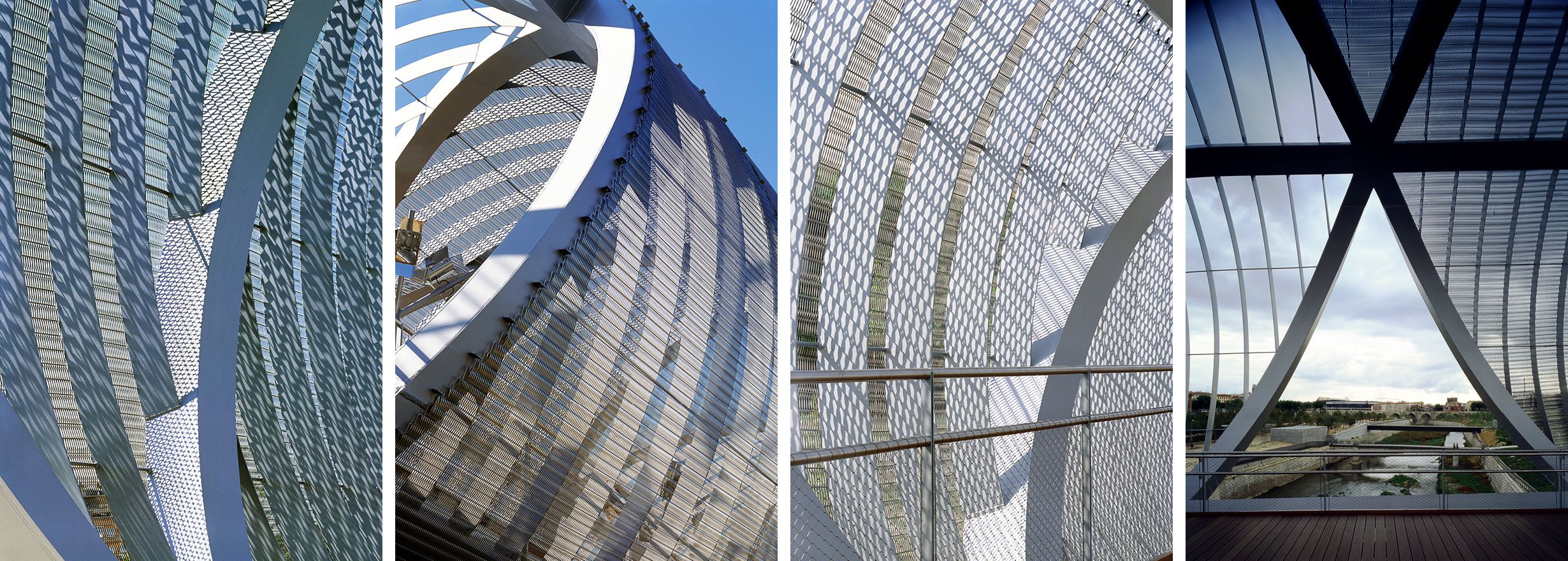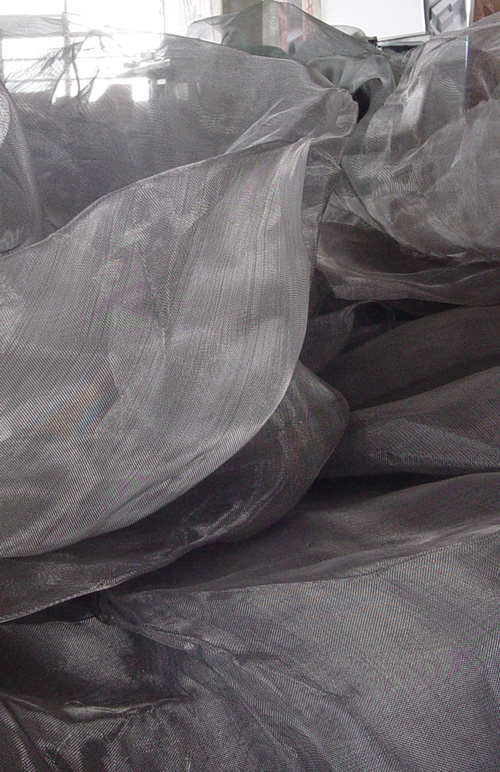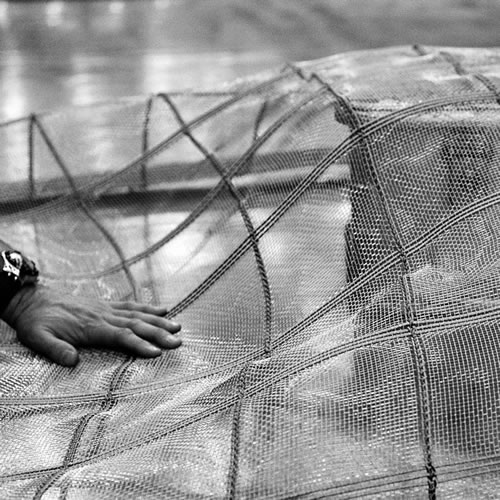Details of the metallic mesh on the Arganzuela footbridge

The stuff of heroes
By Francis Rambert

It is common knowledge that France is a land fixated on concrete, courtesy of Le Corbusier. Art consists in making prowess rhyme with finesse. All those concrete sails… But if this material has thrilled generations of architects, it hasn’t managed to excite Dominique Perrault, the leading light of 80s architecture, who elected to take another path: that of weaving.
Before winning the competition for François Mitterrand’s grandest projects at the age of 35, he’d made his entrance on the architectural scene in 1987 with his project for the ESIEE Engineer’s school in Marne la Vallée; a perfectly identifiable building when seen from a plane: a giant computer keyboard.
But that isn’t the only interest this emblematic building has, since the entrance as well as some of the ceilings are handled with textile fabric, according to a technique deriving from sailing ships and other racing craft. Perrault had woven his fist net… An undeformable net in PVC. And having done that, it was clear he’d have to develop this type of transfer on a larger scale.
His first opportunity: the Bibliothèque nationale de France in Paris, for which it was vitally important, given the “XXXL” size of the project, to find “industrial” solutions. Yet if fabric is indeed present in this monument – notably in the rare and precious book-reading rooms where two strips of white PVC are laced together – it could not be deployed over large surfaces, because of fire regulations. Wear and tear and strength were the other criteria for choosing steel mesh.
No less than three years were necessary to develop this technique which had never before been applied to the building industry. The challenge was to make this technological transfer while adapting it ti building costs. This is the outcome of a unique collaboration between architect and industrialist, the number one in the weaving industry GKD, a German enterprise in the Ruhr which has opened uo, in passing, a previously unsuspected marker for the company.
A trial remained to be undertaken. The small building of the Archives départementales de la Mayenne in Laval (1989-1993) – a wooden box attached to a stone box – was the testing ground for a woven mesh hung in the reading-room. A convincing tryout. The huge metal curtain has a lot of body and a good hang. Not a kink, and sufficient bearing to form a beautiful curve.
The Bibliothèque nationale de France is a catalog in itself of variations on this mesh theme, from the architecture to the furnishings. Outside and inside, a mass of plaiting everywhere that endlessly strive to establish a dialog between the warmth of wood and the coldness of steel and glass.
This unique experiment in large-scale weaving, and on a wide variety of supports, weaves into a logic of experimentation and makes full use of its effects.
The first effect is graphic: an investigation of texture, transparency, moiré effects. The mesh protects as much as it suggests, and encourages seeing without being seen. In his own way Perrault revisits the moucharaby… In this play of woof and weft, the light enjoys itself with the kind of nuances summed up by the word “filter.” Take the spiraling mesh that covers the end walls of the towers up to a height of 80 meters. Let in by holes in the netting, the natural light enmeshes with the grating of the stairways. As for the artificial light, this is spectacularly reflected by an enormous “butcher’s apron,” the silvery drop curtain in the auditorium, which echoes the lamé material of certain dresses.
The second effect is phonic in kind. This mesh, which picks up the light, also traps the sound, and hence the acoustic screens or the batteries of metal sound-absorbers are no longer required in many parts of the library. These huge rollers, akin to hair-curlers, are suspended above the readers’ heads.
The third effect turns out to be practical: “The metal mesh provides us with a continuous, uninterrupted material over hundreds and hundreds of square meters,” Perrault sums up. Proof of that is the metal skin, with nary a fold, which cloaks the ceilings and concrete walls of the vast reading-room. And one of its most spectacular applications remains the immense funnel leading to the room used by researchers, those privileged souls who, cut off from the world, have their minds on their books and their heads in the forest planted at the heart of the project… The walls of this vertiginous space are sheathed in gigantic ribs of netting; a modern, monochrome tapestry which adds to the dramatization of the space.
Yet this whole undertaking manifestly aims at a something else: to erase all style, form and notion of design. Seeing these four almost-blind towers – blind because they’re interiorly faced in wood – it is hard to gainsay Perrault and his theory of effacement, which argues for “an evacuation of the notion of façade.”
On that plane the Berlin sports complex is exemplary. The skin of the two, semi-buried buildings – the cycle track and the swimming pool – is all of a piece, and metal. The effects of brightness vary according to the geometry; the rectangle sets off the circle. Both the roof and the façades consist of the same woven metal. Thus the “fifth façade” predominates over the others, with powerful springs keeping the mesh horizontal. The cylinder, 142 meters in diameter, makes for dazzling reflections as the sun moves into the sky. “The reliability of this material is exceptional,” says Perrault. “One gets a high level of performance from every square meter, nothing is left to chance.”
Other sites, others meshes. In Geneva, Perrault has dreamed up a “dust-sheeted” building. An extremely fine mesh, like silk thread, will envelop a parallelepiped. This is the metal-feeding technique used in industry, but rejigged in a vertical direction here. Apart from testing its strength (a point already verified, the office says), the challenge lies in its resistance to stains. While the heavy-gauge mesh has the advantage of being self-cleaning, the fine-gauge retains the dirt.
Lastly, in the Barcelona suburbs, Perrault is to realize an old ambition: to “cast” a net over a building. One recalls his competition project for a second engineering school in Marne-la-Vallée (the famous Ecole des Ponts et chaussées). Though not selected, this scheme nevertheless gained him the special jury prize in 1989: a crumpled net shrouding an impeccable block.
In Catalonia the job in hand is to build a stadium. The edifice for the Montigalà site must do its best to fit into the valley. If in Berlin Perrault created a landscape, on the outskirts of Barcelona he is leaning on the landscape. And hence the idea was born of a crater covered over with a huge, formless ten 3.5 hectares in size, and woven of metal. “A mesh that will act as a membrane,” promises Perrault, who wants to experiment with the differing gaps of the mesh. And in order to convincingly create the effect of a net, the forest of poles that holds the whole thing up won’t keep the metal fabric taut. From one project to the next, Perrault weaves his webs, plaits his nets, constructs his architecture… Some twenty years after Paco Rabanne – whose famous metal dress one well remembers – the architect of the Bibliothèque de France acts the couturier on buildings whose sexiness (or otherwise) we will leave it up to the fashion writers to ratify. After all, among his braids and his weaves, Perrault remains bravely wise.
The development of metallic fabrics for architecture and design
By Stephan Kufferath, director at GKD
 "In 1992 GKD – a leading weaver of woven metals with manufacturing units in Germany, the USA, Spain and South Africa –
established a first contact with Dominique Perrault endeavoring to assist this
famous as well as innovative architect in his interest and research on woven
metals for use in architecture, particularly focusing on the interior design of
the Bibliothèque nationale de France. On previous projects Perrault had already
worked with synthetic fabrics, but for the Library only non- inflammable
materials, such as metallic fabrics, could be accepted.
Interesting technical aspects of
stainless steel meshes were discovered, such as resistance, durability,
rigidity under tension, maintenance, acoustic qualities, etc. Metallic fabrics
often solve several functional problems at once, problems that the architect
would otherwise have to deal with one by one.
In addition to these purely functional
aspects, design questions and aesthetics came more and more into play: the mesh’s
light reflection properties, the silk-like elegance of the material, the
variable semi-transparency, and the GKD-specific ability to weave these fabrics
in extra-large pieces, up to 8 meters wide.
Dominique Perrault was led to comment: “These
large fabrics interested us as a new architectural idiom, finally freeing us
from the need to use large numbers of discrete modular elements. With these
large pieces of fabric, we obtained surfaces that could be hung wall-to-wall,
wall-to-ceiling, unified and seamless. This underscored the architecture,
creating places that are, metaphorically speaking, hollowed out, continuous,
unassembled. An architecture of sculptured masses.”
The discussions we had with Dominique
Perrault from the very beginning of our joint work and research gave us a
completely new vision of our product, and at the same time set us new technical
challenges. Wire-weaving companies are used to dealing with very tight
tolerances; precision with regard to mesh size, wire diameters, flatness of the
fabric, are standard requirements of such industrial clients as automobile
makers, aircraft companies, the food industry and the like. Perrault’s approach
was different: he wanted to stress the liveliness and irregularity of woven
fabric. Consequently, Perrault guided us towards product modifications
corresponding to architectural requirements. During many months of very close
and intense interactive testing, Perrault and GKD experimented with many
different mesh sizes, wire shapes, wire diameters, cables and threads in order
to endow, as Perrault said, “the meshes with a form, a design in the manner of
fashion designers.”
The first test work that GKD carried out
for Dominique Perrault was not in the Library, but in the Archives
départementales de la Mayenne in Laval, France. Perrault designed a huge curved
ceiling-to-wall application which is still cited today as a prime example of
the optimum use of metallic fabrics in buildings. After that we concentrated on
the ceilings of the Bibliothèque nationale de France, which resulted in various
type of ceiling, undulating or taut, made from different mesh types for a dozen
different applications in the building. Starting with this, GKD has answered
the demands of various other architects and projects in all parts of the world.
This proves that the basic research work initiated by Dominique Perrault was
going in the right direction. The more we continue our research, the more we
discover further technical, functional and aesthetic characteristics in the product.
This confirms our opinion that metallic fabrics in architecture will be around
for much longer than if they were a mere fashion trend.
Our work with Dominique Perrault has
continued with his enormous Olympic projects in Berlin. The approach here has
been completely different. To spread a giant table cloth over two tables in a
garden, while at the same time giving them the light-reflecting quality of
water in a lake, was difficult for us to imagine at first. These projects
displayed Perrault’s incredible creativity and imagination once again. We
followed him technically, but only really understood when we saw the fantastic result.
At present GKD is working with Dominique
Perrault on several new projects. Perrault never copies anything from the past;
he seeks to go further, but in a different direction. We are happy to think
that thus far we have only gone a few steps along the road which stretches
before us.”
"In 1992 GKD – a leading weaver of woven metals with manufacturing units in Germany, the USA, Spain and South Africa –
established a first contact with Dominique Perrault endeavoring to assist this
famous as well as innovative architect in his interest and research on woven
metals for use in architecture, particularly focusing on the interior design of
the Bibliothèque nationale de France. On previous projects Perrault had already
worked with synthetic fabrics, but for the Library only non- inflammable
materials, such as metallic fabrics, could be accepted.
Interesting technical aspects of
stainless steel meshes were discovered, such as resistance, durability,
rigidity under tension, maintenance, acoustic qualities, etc. Metallic fabrics
often solve several functional problems at once, problems that the architect
would otherwise have to deal with one by one.
In addition to these purely functional
aspects, design questions and aesthetics came more and more into play: the mesh’s
light reflection properties, the silk-like elegance of the material, the
variable semi-transparency, and the GKD-specific ability to weave these fabrics
in extra-large pieces, up to 8 meters wide.
Dominique Perrault was led to comment: “These
large fabrics interested us as a new architectural idiom, finally freeing us
from the need to use large numbers of discrete modular elements. With these
large pieces of fabric, we obtained surfaces that could be hung wall-to-wall,
wall-to-ceiling, unified and seamless. This underscored the architecture,
creating places that are, metaphorically speaking, hollowed out, continuous,
unassembled. An architecture of sculptured masses.”
The discussions we had with Dominique
Perrault from the very beginning of our joint work and research gave us a
completely new vision of our product, and at the same time set us new technical
challenges. Wire-weaving companies are used to dealing with very tight
tolerances; precision with regard to mesh size, wire diameters, flatness of the
fabric, are standard requirements of such industrial clients as automobile
makers, aircraft companies, the food industry and the like. Perrault’s approach
was different: he wanted to stress the liveliness and irregularity of woven
fabric. Consequently, Perrault guided us towards product modifications
corresponding to architectural requirements. During many months of very close
and intense interactive testing, Perrault and GKD experimented with many
different mesh sizes, wire shapes, wire diameters, cables and threads in order
to endow, as Perrault said, “the meshes with a form, a design in the manner of
fashion designers.”
The first test work that GKD carried out
for Dominique Perrault was not in the Library, but in the Archives
départementales de la Mayenne in Laval, France. Perrault designed a huge curved
ceiling-to-wall application which is still cited today as a prime example of
the optimum use of metallic fabrics in buildings. After that we concentrated on
the ceilings of the Bibliothèque nationale de France, which resulted in various
type of ceiling, undulating or taut, made from different mesh types for a dozen
different applications in the building. Starting with this, GKD has answered
the demands of various other architects and projects in all parts of the world.
This proves that the basic research work initiated by Dominique Perrault was
going in the right direction. The more we continue our research, the more we
discover further technical, functional and aesthetic characteristics in the product.
This confirms our opinion that metallic fabrics in architecture will be around
for much longer than if they were a mere fashion trend.
Our work with Dominique Perrault has
continued with his enormous Olympic projects in Berlin. The approach here has
been completely different. To spread a giant table cloth over two tables in a
garden, while at the same time giving them the light-reflecting quality of
water in a lake, was difficult for us to imagine at first. These projects
displayed Perrault’s incredible creativity and imagination once again. We
followed him technically, but only really understood when we saw the fantastic result.
At present GKD is working with Dominique
Perrault on several new projects. Perrault never copies anything from the past;
he seeks to go further, but in a different direction. We are happy to think
that thus far we have only gone a few steps along the road which stretches
before us.”AA.VV , With, Barcelona-Basel, ACTAR / Birkhäuser 1999.